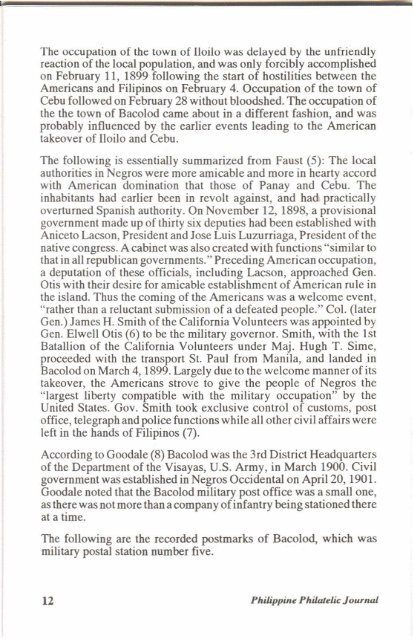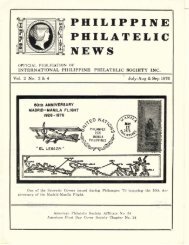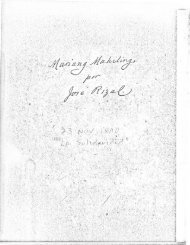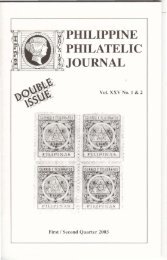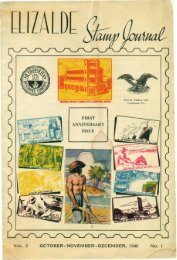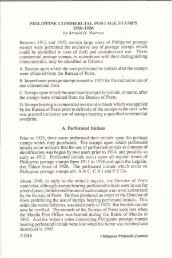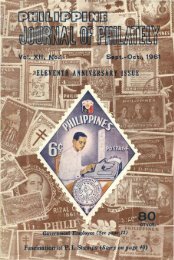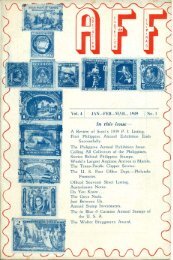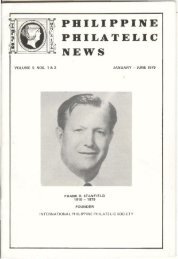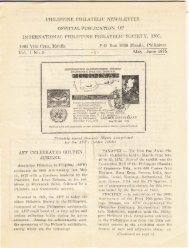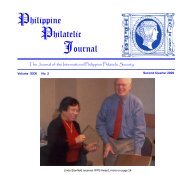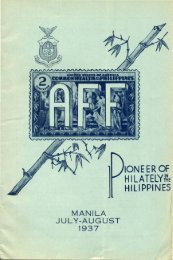Fourth Quarter 1997 - International Philippine Philatelic Society
Fourth Quarter 1997 - International Philippine Philatelic Society
Fourth Quarter 1997 - International Philippine Philatelic Society
Create successful ePaper yourself
Turn your PDF publications into a flip-book with our unique Google optimized e-Paper software.
The occupation of the town of Iloilo was delayed by the unfriendly<br />
reaction ofthe local population, and was only forcibly accomplished<br />
on February 11, 1899 following the start of hostilities between the<br />
Americans and Filipinos on February 4. Occupation of the town of<br />
Cebu followed on February 28 without bloodshed. The occupation of<br />
the the town of Bacolod came about in a different fashion, and was<br />
probably influenced by the earlier events leading to the American<br />
takeover of Iloilo and Cebu.<br />
The following is essentially summarized from Faust (5): The local<br />
authorities in Negros were more amicable and more in hearty accord<br />
with American domination that those of Panay and Cebu. The<br />
inhabitants had earlier been in revolt against, and had practically<br />
overturned Spanish authority. On November 12, 1898, a provisional<br />
government made up ofthirty six deputies had been established with<br />
Aniceto Lacson, President and Jose Luis Luzurriaga, President ofthe<br />
native congress. A cabinet was also created with functions "similar to<br />
that in all republican governments." Preceding American occupation,<br />
a deputation of these officials, including Lacson, approached Gen.<br />
Otis with their desire for amicable establishment ofAmerican rule in<br />
the island. Thus the coming of the Americans was a welcome event,<br />
"rather than a reluctant submission of a defeated people." Col. (later<br />
Gen.) James H. Smith of the California Volunteers was appointed by<br />
Gen. Elwell Otis (6) to be the military governor. Smith, with the 1st<br />
Batallion of the California Volunteers under Maj. Hugh T. Sime,<br />
proceeded with the transport St. Paul from Manila, and landed in<br />
Bacolod on March 4,1899. Largely due to the welcome manner of its<br />
takeover, the Americans strove to give the people of Negros the<br />
"largest liberty compatible with the military occupation" by the<br />
United States. Gov. Smith took exclusive control of customs, post<br />
office, telegraph and police functions while all other civil affairs were<br />
left in the hands of Filipinos (7).<br />
According to Goodale (8) Bacolod was the 3rd District Headquarters<br />
of the Department of the Visayas, U.S. Army, in March 1900. Civil<br />
government was established in Negros Occidental on April 20, 1901.<br />
Goodale noted that the Bacolod military post office was a small one,<br />
as there was not more than a company ofinfantry being stationed there<br />
at a time.<br />
The following are the recorded postmarks of Bacolod, which was<br />
military postal station number five.<br />
12 <strong>Philippine</strong> PhiJaJelic Journal


